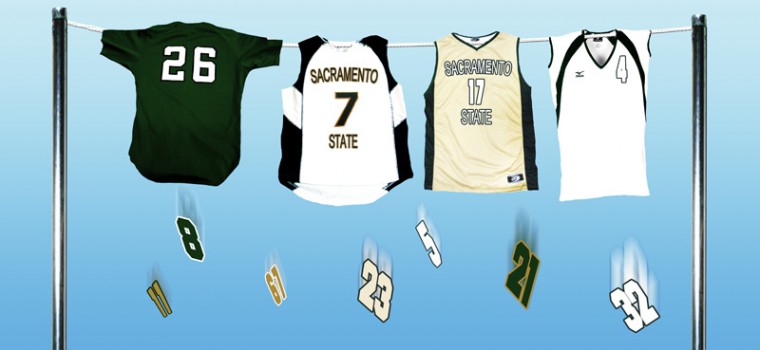What’s the story behind jersey numbers?
April 8, 2009
What’s in a name? Perhaps William Shakespeare’s Romeo had it right. A rose by any other name might still smell as sweet, but Jordan by any number but 23 would be one foul-smelling mistake. In sports, numbers hold limitless power. Above all, they are insurmountably practical. Coaches, referees, fans and other players all utilize jersey numbers for recognition. In the oh-so-glamorous world of sports, numbers are the name. Sorry, Romeo.
Soccer traditionally assigned numbers based on a player’s position. Number one was for the goal keeper and numbers two through 11 were for the rest of the starting lineup, starting in the backfield and moving to the front. Higher numbers were for the substitutes. This numbering standard was initiated for the 1954 World Cup and remained until 1993.
Junior communications major Danielle Holloway paid no mind to the old numbering system when picking her soccer jersey number. She said her number 10 jersey is a highly regarded number in her sport and it tends to be worn by good players. “There’s always a fight over number 10,” she said.
Superstition has always played an important role in sports and also in choosing numbers. Take baseball’s original numbering for example. Traditionally, baseball jersey numbers coincided with the batting order.
Numbers one through eight were designated for the first eight batters and nine was for the backup catcher. Numbers 10, 11, 12 and 14 were for the starting pitchers. Number 13 was considered bad luck and typically not worn, though a few players have given it a try. Alex Rodriguez of the New York Yankees currently wears jersey number 13. Perhaps a superstitious person would credit his number choice to the steroid press he has recently been linked to.
Although Major League Baseball has gone away from its numbering roots, it still plays a role in some of the numbers today. The Yankees have famously retired 15 jersey numbers, more than any other team in the MLB. Because most of those numbers were from older players who recognized the old numbering system, most of the single-digit numbers have been retired. The Yankees tend to have higher jersey numbers today, and only give single-digit numbers to very important players. In fact, numbers six and two are the only numbers remaining below double-digits. Derek Jeter’s number two is currently the only single-digit on the team.
Basketball – primarily in high school and college – does not have a shortage of single-digit numbers. In basketball, one though five are the only allowed numbers, even in double-digits. For example, 34 would be allowed because three and four are both single digits, while 67 would not be allowed.
The National Basketball Association has never mandated the numbering rule, though it is recognized in most organizations outside of the NBA. It is mainly used to make non-verbal communication between the referees and coaches or the scoring table less complicated. Referees need to be able to flash the jersey with their hands and cannot do so with higher numbers.
The rule is commonly followed in middle school where kids are likely to receive their first jersey number. That doesn’t mean that kids know or understand these rules. Jeremy Phillips, a 12-year-old basketball player at Bear River Middle School in Wheatland, Calif., was disappointed that he couldn’t wear jersey number 28. He was unaware that eight was not a legal number. “We got our numbers by size,” said Phillips of his number 23. He’s probably too young to know Jordan and not interested enough to know LeBron.
Traditional numbering systems may mean little to aspiring athletes today, but tradition is still alive and well. Children pick their jersey numbers to imitate their favorite baseball player or because their big brother wore the same number. It becomes essential to wear the same number year after year because you begin to identify with it; it is an extension of you.
For junior English major Justin Eller, the number 40 basketball jersey he wears is more than an extension of himself. It is a representation of his former teammate. While Eller was playing for the College of Siskiyous, he was unfortunate enough to have a teammate pass away. He made the switch from jersey number 50 to number 40, in honor of his lost friend. “After that, I wore his number for the remainder of my college career,” Eller said.
Many youngsters first starting out in their respective sports aren’t given the opportunity to pick a jersey number; they’re often assigned one. You have a clean slate to begin your years of athletics and that number is there with you throughout your journey. It holds your blood, sweat and tears. It can retell your most glorified memories and it knows the heartache from the most painful losses. Your number represents you, and you it.
Dawn Johnson can be reached at [email protected]













































































































































